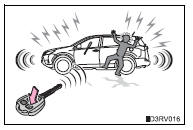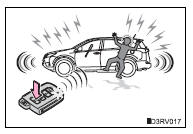Toyota RAV4 (XA40) 2013-2018 Owners Manual: Wireless remote control
Function summary
The wireless remote control can be used to lock and unlock the vehicle.
It also opens and closes the back door.
Vehicles without a smart key system
- Locks all the doors
- Unlocks all the doors
Pressing the button unlocks the
driver’s door. Pressing the button
again within 3 seconds unlocks the
other doors. 
- Sounds the alarm (press and hold)
- Opens and closes the power back door (press and hold)*
Pressing the button while the back door is opening/closing stops the operation.
*: If equipped
Vehicles with a smart key system
- Locks all the doors
- Unlocks all the doors
Pressing the button unlocks the driver’s door. Pressing the button again within 3 seconds unlocks the other doors.
- Opens and closes the power
back door (press and hold)

Pressing the button while the back door is opening/closing stops the operation.
- Sounds the alarm (Press and hold)
Operation signals
Doors: a buzzer sounds and the emergency flashers flash to indicate that the doors have been locked/unlocked. (Locked: once; unlocked: twice) power back door (if equipped): a buzzer sounds and the emergency flashers flash twice to indicate that the back door is opening/closing.
Door lock buzzer
If an attempt to lock the doors is made when a door is not fully closed, a buzzer sounds continuously for 5 seconds. Fully close the door to stop the buzzer, and lock the vehicle once more.
Power back door operation (vehicles with a power back door)
The back door can be opened even if it is locked. The back door and side doors will be unlocked when the power back door is opened. Lock all the doors again when you leave the vehicle. All the doors will not lock automatically after the back door has been opened and then closed.
Panic mode
Vehicles without a smart key system
When 
is pressed for longer than
about one second, an alarm will sound
intermittently and the vehicle lights will
flash to deter any person from trying to
break into or damage your vehicle.
To stop the alarm, press any button on the
wireless remote control.

Vehicles with a smart key system
When  is
is
pressed for longer than
about one second, an alarm will sound
intermittently and the vehicle lights will
flash to deter any person from trying to
break into or damage your vehicle.
To stop the alarm, press any button on the
electronic key. 
Security feature
If a door is not opened within approximately 60 seconds after the vehicle is unlocked, the security feature automatically locks the vehicle again.
Conditions affecting operation
Vehicles without a smart key system
The wireless remote control function may not operate normally in the following situations.
- Near a tv tower, radio station, electric power plant, airport or other facility that generates strong radio waves
- When carrying a portable radio, cellular phone or other wireless communication device
- When multiple wireless keys are in the vicinity
- When the wireless key has come into contact with, or is covered by a metallic object
- When a wireless key (that emits radio waves) is being used nearby
- When the wireless key has been left near an electrical appliance such as a personal computer
Vehicles with a smart key system
If the wireless remote control does not operate properly (vehicles with a smart key system)
Locking and unlocking the doors: use the mechanical key.
Key battery depletion
- Vehicles without a smart key system
If the wireless remote control function does not operate, the battery may be depleted. Replace the battery when necessary.
- Vehicles with a smart key system
When the electronic key battery is fully depleted
Confirmation of the registered key number
The number of keys already registered to the vehicle can be confirmed. Ask your toyota dealer for details.
Customization
Settings (e.G. Wireless remote control system) can be changed.
Certification for wireless remote control (vehicles without a smart key system - type a)
For vehicles sold in the u.S.A., Hawaii, guam, saipan, american samoa and nato germany
Fcc id: hyq23aac
Fcc id: hyq12bdm
Note:
This device complies with part 15 of the fcc rules. Operation is subject to the following two conditions: (1) this device may not cause harmful interference, and (2) this device must accept any interference received, including interference that may cause undesired operation.
Fcc warning: changes or modifications not expressly approved by the party responsible for compliance could void the user’s authority to operate the equipment.
For vehicles sold in canada
Note:
This device complies with industry canada licence-exempt rss standard(s).
Operation is subject to the following two conditions: (1) this device may not cause interference, and (2) this device must accept any interference, including interference that may cause undesired operation of the device.
Certification for wireless remote control (vehicles without a smart key system - type b)
<Rke transmitter, tpm/rke integrated receiver> trw automotive
Automobile entry/security transmitter
Model: 226624-101, 226624-102
Fcc id: gq4-52t
Ic: 1470a-33t
Auto alarm/security system receiver
Model: 230433
Fcc id: gq4-45r
Made in u.S.A.
This device complies with part 15 of the fcc rules and with industry canada license-exempt rss standard(s). Operation is subject to the following two conditions:
- This device may not cause harmful interference, and
- This device must accept any interference received, including interference that may cause undesired operation of the vehicle.
Le présent appareil est conforme aux cnr d’industrie canada applicables aux appareils radio exempts de licence. L’exploitation est autorisée aux deux conditions suivantes :
- L’appareil ne doit pas produire de brouillage, et
- L’utilisateur de l’appareil doit accepter tout brouillage radioélectrique subi, même si le brouillage est susceptible d’en compromettre le fonctionnement.
Warning: changes or modifications not expressly approved by trw automotive u.S. Llc could void the user’s authority to operate the equipment.
Certification for wireless remote control (vehicles with a smart key system)
For vehicles sold in the u.S.A., Hawaii, guam, saipan, puerto rico, american samoa and nato germany
Fcc id: hyq23aab
Fcc id: hyq14fba
Fcc id: ni4tmlf10-13*
Fcc id: ni4tmlf10-51*
*: U.S.A. Only
Note:
This device complies with part 15 of the fcc rules. Operation is subject to the following two conditions: (1) this device may not cause harmful interference, and (2) this device must accept any interference received, including interference that may cause undesired operation.
Fcc warning:
Changes or modifications not expressly approved by the party responsible for compliance could void the user’s authority to operate the equipment.
- For vehicles sold in canada
Note:
Operation is subject to the following two conditions: (1) this device may not cause interference, and (2) this device must accept any interference, including interference that may cause undesired operation of the device.
This device complies with industry canada licence-exempt rss standard(s).
Operation is subject to the following two conditions: (1) this device may not cause interference, and (2) this device must accept any interference, including interference that may cause undesired operation of the device.
 Antenna location and effective range
Antenna location and effective range
Antenna location
Antennas outside the cabin
Antennas inside the cabin
Antenna outside the luggage
compartment
Effective range (areas within which the electronic key is
detected)
...
 Side doors
Side doors
Unlocking and locking the doors
The vehicle can be locked and unlocked using the key, entry function,
wireless remote control or door lock switch.
Entry function (if equipped)
Wireless remote cont ...
Other materials:
Using the aux port
This port can be used to connect a portable audio device and listen
to it using the vehicle’s speakers.
Open the cover and connect
the portable audio device.
Press the “media” button repeatedly until “aux” is displayed.
Silencing a sound
Press
(mute).
To cancel, p ...
Gauges and meters (with 12.3-inch multi-information display)
The meters display various drive information.
Meter display
â– Locations of gauges and meters
The meter type can be changed on
of the multi-information display.
Type 1/Type 2
The units of measure may differ depending on the intended destination of
the vehicle.
Multi-information display
Presen ...
Reassembly (2005/11-2006/01)
Install drive shaft bearing case subassembly
Using sst and a press, press in the drive shaft
bearing case to the inboard joint rh.
Sst 09527-10011, 09710-04081
Notice:
The bearing should be installed completely.
Using a snap ring expander, install a new drive shaft
hole ...
